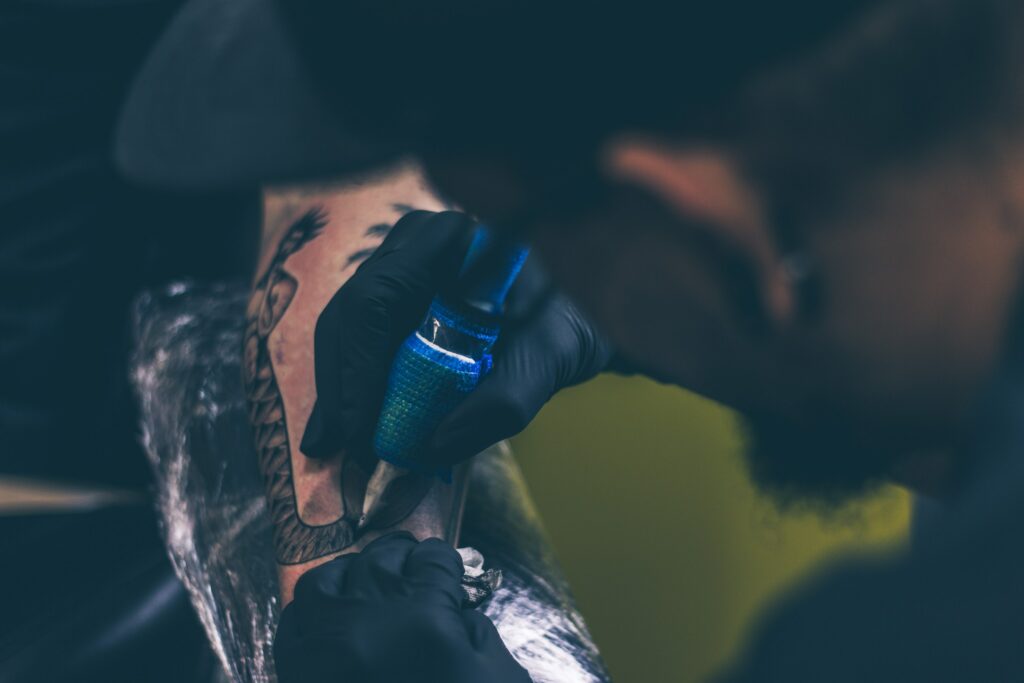Porcelain Tattoo, In the vast and diverse realm of body art, few trends capture the elegance and timelessness of traditional arts like the “porcelain tattoo.” A harmonious blend of age-old porcelain designs and the edgy, contemporary medium of tattooing, the porcelain tattoo offers a unique aesthetic that bridges cultures and epochs. By marrying intricate patterns once reserved for royal tables and ancient heirlooms with the personal canvas of human skin, this style redefines the boundaries of both porcelain artistry and modern tattooing.
Contents
Historical Context of Porcelain Art
Porcelain, often dubbed ‘white gold,’ has its roots deeply embedded in the annals of history, particularly within the rich cultural tapestry of China. This prized ceramic, renowned for its translucency and strength, was a testament to the unparalleled craftsmanship of ancient Chinese artisans. It became an emblem of prestige and sophistication, sought after by emperors and nobility, and was a significant export that fueled trade along the famed Silk Road.
Several factors have immortalized porcelain in cultural and artistic lore. First and foremost, its manufacturing process was a guarded secret, shrouded in mystery for centuries. The perfect amalgamation of kaolin clay and petuntse fired at incredibly high temperatures resulted in a ceramic unmatched by any other in durability and finesse.
One of the defining features of traditional porcelain designs is their intricate patterns, typically rendered in cobalt blue against a stark white background. These designs, inspired by nature, folklore, and daily life, were not merely ornamental; they were symbolic narratives. Dragons often represented power and strength, while phoenixes symbolized renewal. Floral motifs, such as peonies and chrysanthemums, were emblematic of beauty and resilience, respectively.
Another key characteristic of porcelain art is its form. From slender vases depicting pastoral scenes to robust plates adorned with detailed borders, each piece was a canvas that told a tale, encapsulating a moment, a feeling, or a message from the artist to the beholder.

Evolution of the Porcelain Tattoo Trend
The convergence of traditional porcelain designs with modern tattoo artistry was not an overnight phenomenon. The origins of the porcelain tattoo trend can be traced back to tattoo enthusiasts and artists who sought inspiration beyond the conventional realms of body art. They looked toward cultural heritages, and among the myriad of artistic expressions, the timeless beauty of porcelain designs caught their attention.
In the early stages, porcelain-inspired tattoos were sporadic, standalone pieces that drew admiration for their novelty and intricacy. However, as more tattoo aficionados recognized the elegance and depth of these designs, what began as individual expressions grew into a full-fledged trend.
The influence of porcelain patterns on modern body art is profound. Just as traditional porcelain pieces told stories through patterns and symbols, porcelain tattoos became a canvas for personal narratives, often infused with the wearer’s cultural roots, memories, or aspirations. The iconic blue and white color scheme, emblematic of classic porcelain, became a popular choice, lending tattoos a vintage yet timeless appeal.
While the trend has seen a grassroots evolution, it’s undeniable that the limelight cast by notable artists and celebrities has accelerated its popularity. Renowned tattoo artists began showcasing porcelain-inspired designs in their portfolios, each with their unique spin, further solidifying the style’s position in contemporary tattoo culture. Celebrities, ever the trendsetters, embraced porcelain tattoos, either as a nod to their heritage or simply for the art’s inherent beauty. Their endorsements, whether on red carpets or social media, introduced the trend to a broader audience, cementing its place in the tattoo zeitgeist.
Characteristics of a Porcelain Tattoo
The allure of a porcelain tattoo lies not only in its rich historical connections but also in its distinct aesthetic and technical elements. When envisioning a porcelain tattoo, there are specific characteristics that define this unique style.
1. Color Palette: At the heart of the porcelain tattoo’s visual appeal is its color scheme. The iconic blue and white palette, reminiscent of classic porcelain wares, dominates this style. The deep cobalt blue, often with varying shades, juxtaposes brilliantly against the stark white (or natural skin tone), creating a captivating visual contrast. While blue and white are the hallmarks, some artists and wearers occasionally introduce other subtle colors, like gold or soft pastels, to add dimension or personal touch.

2. Tattoo Techniques: To achieve the intricacy and finesse of porcelain designs on the skin, specialized tattooing techniques are imperative. Fine line tattooing, known for its precision and delicacy, is frequently employed to replicate the minute details of traditional patterns. Additionally, the shading and dotwork techniques help in capturing the gradient and depth, ensuring the design’s authenticity and vibrancy on the skin’s canvas.
3. Design and Placement: Porcelain tattoos, given their intricate nature, often demand larger canvases to truly shine. As such, they’re commonly found on areas like the forearm, thigh, back, or even the ribcage, allowing for the design to sprawl and showcase its details. Popular design choices encompass a range from nature-inspired motifs (like flowers, birds, or landscapes) to mythical creatures like dragons or phoenixes. Often, the designs are framed within geometric shapes or mimic the curvature of porcelain wares, such as plates or vases.
Symbolism and Meaning So, Porcelain Tattoo
In the world of tattoos, where each inked design often carries a profound personal meaning, porcelain tattoos stand out for their layers of symbolism and connection to a rich historical tapestry. But what is it that draws individuals to this style, and what meanings are embedded within these intricate designs?
1. Personal Narratives: For many, a porcelain tattoo is not merely an adornment but a visual diary on the skin. It might encapsulate a cherished memory, a tribute to a loved one, or a mark of a significant life event. The stories that traditional porcelain pieces once told are given a fresh, personal context, transforming them into deeply intimate tales of the wearer’s life journey.
2. Heritage and Tradition: Porcelain tattoos serve as a bridge, connecting wearers to their cultural roots. For individuals with East Asian ancestry, especially Chinese, these designs often hold a profound significance. They become a way to celebrate, honor, and reconnect with their heritage, wearing it proudly as a testament to the rich traditions and histories that have shaped them.
3. Modern Interpretations: While porcelain tattoos are rooted in tradition, they are by no means confined to it. Many wearers and artists infuse these designs with contemporary elements, creating a fusion that speaks to the evolving nature of art and self-expression. Traditional motifs might be juxtaposed with modern symbols, or the iconic blue and white palette might be reimagined in unexpected hues, showcasing the individual’s unique perspective and creativity.
4. Universal Appeal: For others, the allure of porcelain tattoos lies not in personal or cultural connections but in the sheer beauty and artistry of the designs. The motifs, even when devoid of personal history, resonate due to their universal themes of nature, transformation, and the human experience.
Caring for a Porcelain Tattoo
A porcelain tattoo, with its intricate details and vibrant colors, is undoubtedly a visual delight. However, to ensure that its beauty remains undiminished over time, proper aftercare and maintenance are essential. Given the precision and finesse of these designs, their care demands particular attention.
1. Importance of Aftercare: The initial days post-inking are crucial for any tattoo, and this holds especially true for porcelain designs. The intricacy of the patterns means there are more areas where the skin has been punctured and needs to heal. Proper aftercare ensures that the design heals uniformly, retaining its sharpness and vibrancy.

2. Recommendations for Preservation:
- Cleanliness: Keeping the tattoo clean is paramount. Gently washing it with a mild, fragrance-free soap ensures that no dirt or bacteria compromise the design or cause infections.
- Moisturization: Regularly applying a thin layer of tattoo-specific ointment or unscented moisturizer keeps the skin hydrated and aids in the healing process.
- Protection from Sunlight: The sun’s UV rays can cause tattoos, particularly colored ones, to fade over time. When outdoors, protect the tattoo by applying sunscreen or covering it with clothing.
- Avoid Picking: As the tattoo heals, scabs may form over the design. Picking at these can lead to loss of ink and uneven healing, affecting the overall appearance of the tattoo.
3. Potential Challenges and Solutions:
- Fading Colors: All tattoos fade over time, but with colored designs like porcelain tattoos, this is especially noticeable. Periodic touch-ups by a professional can restore the design’s original vibrancy.
- Blurring of Details: Over time, ink may spread slightly under the skin, causing fine details to blur. Ensuring good aftercare, choosing experienced tattoo artists, and considering the tattoo’s placement can minimize this.
- Infections: If the tattoo becomes red, swollen, or excessively painful, it might be infected. It’s essential to consult with a healthcare professional and avoid self-treatment.
Conclusion
The timeless appeal of porcelain designs, with their intricate patterns and rich histories, has proven to be enduring and universally captivating. Their transition from delicate ceramics to the dynamic canvas of human skin underscores the boundless potential of artistic expression. As centuries-old motifs find new life in the realm of modern tattoo artistry, they become symbolic of the harmonious dance between the past and the present.
For those captivated by this art, the porcelain tattoo offers more than just a design; it’s a journey. A journey through history, culture, and personal narratives. It invites wearers and admirers alike to delve deeper, find connections, and appreciate the nuances that make this style so unique. To anyone intrigued by the porcelain tattoo, the invitation is clear: Explore this exquisite fusion of tradition and modernity. Whether it’s to commemorate heritage, celebrate art, or simply adorn oneself with beauty, the porcelain tattoo promises a tale that’s as timeless as the designs it draws inspiration from.





